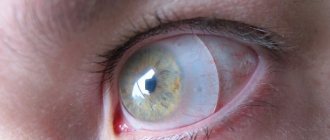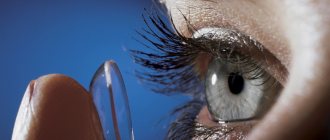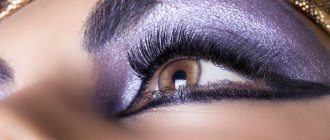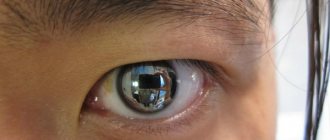Astigmatism is a common visual impairment accompanied by a change in the shape of the lens (from normal spherical to non-spherical). In this case, vision correction is carried out using special glasses or lenses. In this review, we will talk about toric lenses (designed specifically for vision correction with astigmatism) - their types, selection rules, use and care features. Lenses of this type can also be used in childhood.
What it is?
The product is widely used to eliminate pathology caused by curvature of the lens or cornea. As a result, the refraction of the visual apparatus suffers and the picture acquires blurry contours. With astigmatism, a person is unable to see the smallest details. In some cases, vertical lines appear slanted.
Toric lenses create different refractive powers of the organ of vision in the horizontal and vertical directions. This allows you to effectively combat the manifestations of astigmatism. The eyepiece has a unique structure; it has a pair of bulges located at different angles. Thanks to this, focusing occurs on the desired area of the retina and the image becomes clear.
TCLs are divided into several types depending on the material and duration of wear:
- Planned replacement. They are allowed to be used within three weeks;
- One-day. The maximum service life is twenty-four hours. After this, the optics are disposed of. Convenient to use because they do not require additional care;
- Hydrogel. They take a large amount of fluid from the organ of vision, so many patients complain of the development of “dry eye” syndrome;
- Silicone hydrogel. They are considered the best option, characterized by flexibility and high throughput.
| If you are faced with increased dry eyes, then you should choose moisturizing drops. The ophthalmologist should choose a medication after a preliminary examination. |
Application area
Astigmatism is a condition in which visual acuity (optical power) differs in different sections of the eye. Appears as a result of differently reflected light rays when the surface of the cornea is uneven. There is physiological astigmatism, up to one diopter, which has a slight effect on the quality of vision, and is uncorrected to varying degrees. Based on the latter, chronic conjunctivitis, dry eye syndrome and headache can develop.
Visual acuity when using contact correction devices is higher than with glasses (a single optical system is formed with the surface of the cornea). Traditionally, rigid contact lenses have been used to correct astigmatism. Today, the ophthalmic industry produces more comfortable soft lenses that are used more often by patients. Currently, an increasing number of people prefer this method of correction.
Soft and hard
Previously, only hard eyepieces were used to correct astigmatism, which often provoked the development of hypoxia. Modern models differ significantly from their predecessors. They have high throughput and allow oxygen to freely penetrate to the eyes. Due to their cruelty, the products fit tightly to the surface of the organ of vision, therefore they are better able to eliminate astigmatism.
However, such eyepieces also have some disadvantages:
- Long adaptation period;
- Patients may experience individual intolerance to optics;
- When foreign particles penetrate under the “plate,” a person experiences pain and stinging.
You can find hard lenses for night wear on the market. They act in a special way. They are put on before going to bed; during the night's rest, the surface of the cornea is smoothed out and takes on the correct shape. The achieved effect lasts throughout the day. Such a correction requires mandatory consultation with a doctor. The products have a high price tag, however, they can be used for two years without replacement.
Soft lenses preserve the ability of the visual apparatus to maintain a humid environment. They are 100% breathable, the “plate” fits tightly to the cornea and completely follows its shape. Thanks to such characteristics, the adaptation period passes unnoticed.
Among the disadvantages of eyepieces, it is worth noting the fact that with their help it is impossible to increase visual acuity. The lack of the required rigidity does not allow obtaining maximum image clarity. Also, soft optics often cause the eyeball to dry out, so it is necessary to regularly use moisturizing drops. Return to contents
Specifics of wearing mode
Any contact optics requires proper care and compliance with operating standards. Toric eyepieces are divided into several forms depending on the frequency of replacement:
- Traditional. They are allowed to be worn from six to twelve months;
- Planned replacement. The period of use varies from thirty to ninety days;
- Frequently replaced products. These eyepieces are worn for one or two weeks;
- Daily optics. TCL can be used during the day.
According to their mode of operation, lenses are divided into the following categories:
- Daytime wear. Optics are only allowed to be used during daylight hours. Before going to bed, they must be removed and stored in a special disinfecting solution;
- Extended wearing. Can be used without removing for a week. Then you need to give your eyes a rest;
- Flexible wearing. It is allowed to leave the eyepieces overnight, but a maximum of a couple of times;
- Continuous use. Such optics can be worn for a month without removing them. However, in this case, you will have to visit an ophthalmologist once a week for a preventive examination.
Types of lenses
Based on the duration of wearing, this correction device is divided into several types:
| Duration of wearing | Characteristic |
| One-day | Daily contact lenses are presented in 30 pieces in one package. Each of them is in an individual container with a solution. After opening the container and removing the optical system from it, it is thrown away, and the lens itself can be worn for no more than 12 hours. This type of vision-correcting product is intended for daytime wear only; sleeping with it is prohibited. |
| Planned replacement | Planned replacement implies the ability to use one lens for a long period - from two weeks to three months. This type of corrective product can only be worn during the day; at night it must be placed in a container with a special solution. It is recommended to treat the system with a small amount of fresh solution before putting it on again. |
| Continuous wearing | Continuous wear lenses are the most popular due to the ability to keep them in place for a long period of time. Such vision correctors do not require maintenance, are practically not felt in the eyes and are simply irreplaceable for people with irregular or shift work schedules. Their disadvantages are a large load on the eyes, which can lead to headaches and decreased visual acuity. |
There are three types of toric optical system designs:
| Design | Image | Characteristic |
| Prismatic ballast | This technique is intermediate between prismatic ballast and accelerated stabilization. The stabilizing parts in this type of design are located at the bottom of the optical system at 4 and 8 o'clock. This shape reduces friction with the lower eyelid, making the corrective product almost invisible to the eye. In addition, it fits snugly on the eye, without moving when changing body position, providing maximum quality of vision. | |
| Accelerated stabilization | In this case, the stabilizing parts are located on the sides of the lens at 3 and 9 o'clock - two on each side. The marks are located at the top and bottom of the correction agent. The advantage of this design is that the vision corrector does not rotate in the eye when changing body position, which allows patients to see well in any position: standing, sitting, lying on their back or side |
Flaws
Among the disadvantages of the product, doctors and consumers note the following points:
- In some cases, patients are faced with individual intolerance to the material from which the eyepieces are made;
- Hydrogel lenses have poor transmission capacity and can cause oxygen starvation;
- Wearing products for a long period of time leads to changes in the shape of the cornea. TCLs must be located in a strictly defined position, therefore they are equipped with a special locking mechanism.
The following methods are used to stabilize lenses:
- Correction of the curvature of one of the surfaces;
- Cutting off the lower area of the “plate”; the cut is subsequently placed along the edge of the lower eyelid;
- Thickening the optics, creating the so-called prismatic ballast. The lower zone of the product is processed;
- The eyepiece is thinned at the top and bottom in the areas located under the eyelids. To achieve maximum stability, several techniques can be used simultaneously.
There are laser marks on the surface of the eyepieces. This helps to position them correctly in the eyes. Return to contents
What is better - lenses or glasses?
In addition to contact optics, glasses are sometimes used to eliminate astigmatism. Most often they are prescribed to children. Both options have pros and cons. Benefits of glasses:
- They have a lower cost. One model can be worn for a long time;
- Glasses are also used to correct myopia and hypermetropia;
- A simple and affordable method of correction;
- Ideal for patients who, for various reasons, are not suitable for contact lenses;
- If you drop a “record,” it is much more difficult to find than glasses.
However, the method has a number of disadvantages:
- Does not help with severe astigmatism;
- Can lead to headaches and visual fatigue;
- If you choose the wrong optics, your eyes are under constant tension and their sharpness decreases;
- Distortion of object parameters, incorrect assessment of the distance between them, narrowing of peripheral vision;
- When temperatures change, glasses lenses fog up and can easily break.
| If the patient has different visual acuity in the left and right eyes, then doctors advise using contact optics. |
Such products have a number of advantages over glasses:
- Toric lenses correct high degrees of astigmatism;
- Distortion of object parameters is minimal;
- A person gains the opportunity to see fully with the left and right eyes;
- No obstructions to lateral vision.
Among the shortcomings of the product, a number of points are worth noting:
- Cheap eyepieces do not allow oxygen to reach the eyes;
- Some people cannot tolerate having a foreign object in their organ of vision;
- Long-term wearing of TCL can provoke changes in the shape of the cornea.
Each patient decides independently which type of corrective optics to choose, after, of course, consulting with an ophthalmologist.
Difference between spherical and toric lens
Spherical and toric lenses - what are they and what is the difference? The first types are responsible for correcting myopia or farsightedness, while the second, due to their shape, simultaneously perform two optical functions. One indicator is designed to correct astigmatism along a specific meridian, while the other regulates visual acuity.
Toric lenses for astigmatism must be in one position. Their meridians must strictly correspond to the position of the axes of the visual defect. Only in this case will they perform all their functions. A spherical contact lens has a stable refractive power across its entire surface, so it does not matter what position it is in on the cornea.
Tips for choosing lenses
Unlike classical optics, choosing a TCL will take more time. Since, in addition to the usual measurements, spherical and cylindrical components are additionally selected for the patient, and the astigmatism axis is specified. It is also mandatory to identify the radius of curvature and optical power.
For each patient, optics are selected individually, taking into account his professional activity, age, and condition of the visual apparatus. If the lenses are chosen incorrectly, they will begin to constantly shift and it will not be possible to achieve optimal correction.
| Some ophthalmologists use a modern device - a topographer - to select contact optics. With its help, an accurate determination of biometric indicators is carried out, on the basis of which the required optical power for the eyepiece is determined. |
How to wear it correctly
Before starting the procedure, do not forget to wash your hands thoroughly with soap and dry them well:
- Take the lens from the container and make sure it is not inside out. If the edges are curved, the product is not in the correct position. Give it the required shape;
- It is recommended to start the procedure each time with the same eye (for example, the left). This is especially important for toric eyepieces, which may vary in optical power;
- Hold the upper eyelid to eliminate the risk of blinking;
- Pull the lower eyelid slightly with the hand in which you are holding the lens;
- Carefully bring the optic to the organ of vision and insert it. The procedure will be easier if you look to the side or up;
- Then blink a few times until the “plate” snaps into place. Repeat the manipulations with the second eye.
Return to contents
Manufacturers of toric contact lenses
There are several corporations whose product quality has been confirmed by experts and consumers:
- Bausch&Lomb. The American company has held a leading position in the ophthalmology market for many years. The main part of the products is created from silicone hydrogel. PureVision Toric lenses allow oxygen to pass through well and can be worn for a month without removing them;
- Novartis. The Swiss manufacturer sells a high-quality product for the correction of astigmatism. The trademark of this company is CIBA Vision. The eyepieces are made from silicone hydrogel. The Air Optix for Astigmatism product costs on average around one thousand rubles;
- CooperVision. The corporation specializes in the production of lenses for the correction of astigmatism. The main part of the models is made of hydrogel. The most popular are Frequency 55 Toric; three lenses will cost one and a half thousand rubles;
- Johnson&Johnson. The company is the copyright holder of the Acuvue brand. Eyepieces for daily or scheduled replacement are sold on the market under the brand name. The Oasys for Astigmatism model with six lenses included costs approximately one thousand three hundred rubles;
- OKVision. The corporation sells Prima Bio optics individually; one eyepiece has a price tag of around three hundred rubles. The products are created from a unique raw material called hyoxyfilcon A. It retains moisture well and takes care of moisturizing the mucous membrane, so the risk of developing dry eye syndrome is reduced to zero;
- Focus offers Dailies lenses to consumers. One of the popular models is AquaComfortPlus. The price for thirty pieces is a thousand rubles. Basically, hydrogel is used to create optics, but the raw material is highly soft and does not cause discomfort while wearing. Lenses require daily replacement.
| It is the world leader in the ophthalmology market. However, to find the perfect option, you may have to try several models. |
Selection of toric lenses
Toric contact lenses, in addition to fastening, differ in thickness, functionality and color. There are hard and soft, as well as multifocal and color.
- Rigid toric lenses are the pioneers and are where it all started. They are distinguished by good density, which ensures a “merging” effect. But often many people experience irritation and a feeling of a foreign body in the eye.
- Soft toric lenses have replaced hard ones. They are produced thin and elastic, most often from hydrogel or silicone gel.
- A toric intraocular multifocal lens not only provides focusing, but also performs the functions of a conventional multifocal lens for farsightedness. That is, now you don’t need to carry two pairs of glasses with you: for reading and for distance.
- Colored toric lenses perform a corrective function, as well as an aesthetic one.
Any lenses are gas permeable, so do not worry about the oxygen supply to the cornea.
Tips for caring for lenses
The product requires constant care to prevent protein deposits from accumulating on the surface. This will minimize the risk of developing severe ophthalmic diseases:
- After removing the optics, it is necessary to carry out thorough mechanical cleaning. Place the “plate” on your hand and drop a little solution. Then gently rub the inside and outside with your fingertips;
- Place the optics in the container and add a special disinfectant liquid;
- If necessary, use moisturizing drops;
- Carefully monitor the expiration date of the product. Do not put on lenses after the expiration date;
- It is important to regularly clean not only the optics, but also the container for storing them.
Care
Basic rules of care:
- Long-term wear lenses should be wiped with a fingertip after each removal.
- Each time after removal, immerse the products in a special disinfectant solution.
- Do not use the solution after the expiration date.
Under no circumstances should you rinse your lenses with water (especially tap water). Improper care of products can lead to inflammatory eye diseases.









